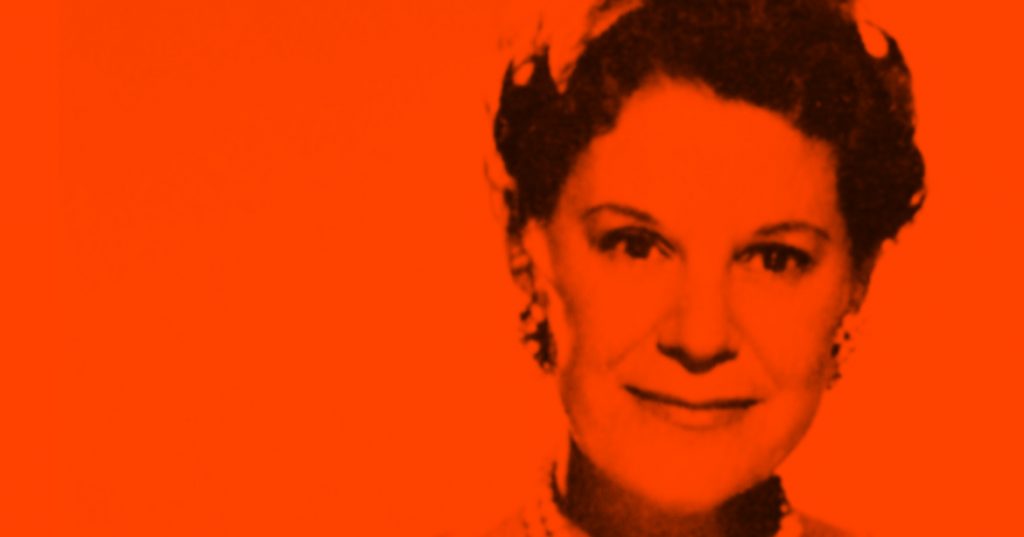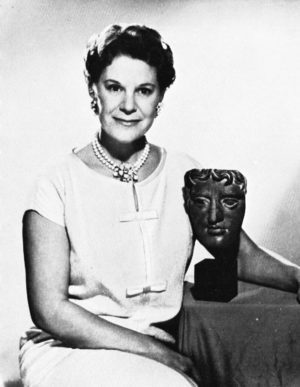The Joan Kemp-Welch story
A snatched interview with the Associated-Rediffusion television director


This is Joan Kemp-Welch’s story. Born Wimbledon 1916. Educated Roedean. Started stage career at 17. Winner of the award of the Guild of Television Producers and Directors for the best producer of light entertainment in 1958. Lively. Determined. Energetic.
Enter room 519, Television House – ‘won’t keep you a moment’, says Joan as she races through a 1959 Show programme with a visitor. ‘I think it’s going to be great’, she ends… ‘all right, thanks very much for coming in to see me, good-bye, see you soon’. Advance to chair in front of desk. Start interview.
‘I always wanted to go on to the stage. But as there was no money to pay for the training, I decided to take up a scholarship I had won to train to be a teacher. Meanwhile I was a member of the amateur society at the “Q” Theatre. Somebody fell ill and I took over the part of a maid. They offered me a year’s contract on the strength of it’. (Aside to her P.A.: ‘Here’s that memo you were asking about’).
‘Just before the war I decided I wanted to produce so I went along to Harry Hanson. I always remember him telling me: “We have enough trouble in the theatre without women producers”. At the beginning of the war I was playing the juvenile lead in “Ladies in Retirement”. That lasted two years. Meanwhile I did two films, one was opposite Bob Montgomery and in the second I was Anna Neagle’s mother in the Amy Johnson film. She has never let me forget that.’
(The phone rings – ‘Miss Joan Kemp-Welch has a visitor at the moment, she will ring you back when she is free’, says her P.A., Gerry Burke.)
Back to Joan: ‘The war brought directors into short supply. I went to Penge for a week to produce for Harry Hanson and I stayed for a month. I have never stopped producing since then. Next I went to Buxton for six months and then on to Colchester for a year-and-a-half. Two of the people I directed there were Dora Bryan (it was her second job) and Paul Rogers.’
(A visitor bursts in to get her to sign some travellers’ cheques. Exit visitor. Back to Joan.)
‘After that came a tour of India and Italy and the end of the war. I went to Scotland to produce for the Wilson Barrett company. I was asked to take over for three weeks from Clare Harris, and I stayed for three years. It was great fun. I produced musicals with a company of sixty artists. We stayed three weeks at each theatre in the circuit at Aberdeen, Glasgow and Edinburgh.’
‘Jacqueline Mackenzie was one of the people working in the wardrobe department. I gave her her first break.’ (The phone rings: ‘Of course you can see me in five minutes,’ she says. The phone is put back. The interview goes on.)
‘We did a series of revues which got fantastic notices. Peter Moffatt wrote the revues – he also selected the music for “Rush Hour” and he is working for me on the “1959 Show”.’
‘Before I left Scotland I was asked to do a panto at Blackpool. This was my first real contact with the variety stars. Olga Gwynne was the principal girl and Dave Morris was the comic. Another panto followed at Aberdeen in which Jackie Hunter starred and Dick Emery played the dame’. (Again the phone rings: ‘Oh, you know that sketch, well I want to have a word with you about it. I’ve cast the match girl.’ It doesn’t make sense but it works – the caller goes).
‘Yes and what year were you at Aberdeen’, you prompt her. ‘I’m so sorry I’m absolutely terrible with dates. Never could remember them’, she replies.
‘Incidentally I had any number of letters of congratulation from friends in Aberdeen and Scotland after winning that award. I was very touched. It is heart warming that they still remember me.’
(Again the phone rings: ‘Certainly, I remember I’ve got an appointment to see you at twelve’). Back to her story…
‘Then I came to Town. I went to Bromley where I produced every third play for J. Arthur Rank, who owned the theatre. Meanwhile I put on a panto written by Peter Moffatt. It was “Goldilocks” and it was an enormous success. Tony Bateman of “Cool for Cats” was the dame – it was his first chance – and Duggie Squire was the bear – he did the choreography of “Cool for Cats”.’
‘During this time I did a lot of Sunday shows for the Repertory Players – twelve in all. They included “Serious Charge” with Nigel Stock, “Shadow of the Vine” with Eric Portman and “Annabella” which we televised last autumn.’
(A letter has to be signed. The ink has run out – ‘We never have things like that. There is never the time to go to the stationery department’, she half apologizes.)
‘Next came “Miss Hargreaves” with Margaret Rutherford at the Royal Court. After that there was “Desire Under the Elms” at Hampstead. Then there was “The Vicious Circle” at the Watergate with Faith Brook and Hugh Burden. It had wonderful notices and it meant I had two shows running at once.’
‘Lloyd Williams came to see “Desire Under the Elms” and asked me to go into television. I had never been inside a television studio in my life. I told him this but he said “never mind we are running training courses”.’
‘Then he came to see “The Vicious Circle” and asked me if I had made up my mind. I took the plunge. It was a bit of a gamble as I had made a success in one medium. It was rather a lot to hope I could do the same in another one.’ (This is said in the most modest way possible before the phone again interrupts… ‘Certainly you can go ahead and arrange that’, she says.)
I did five weeks training and then I was thrown into the first regular transmission put out by Associated-Rediffusion on the day after opening. It was called “How to make a Frame for Flowers” with Elsa Court and was in the women’s programme. I did seven programmes a week for women for three months. We did a twenty-minute revue in a studio the size of a pocket handkerchief’
‘Then I had 10 days off during which I directed and produced “Dead on Nine” at the Westminster Theatre. It ran for a year. Later I had another fortnight off to do “Albertine by Moonlight”. It was a ghastly failure and came off after three nights. The critics hated it.’
‘The funny thing is that although my entire life has been spent doing drama the only play I have done here was “The Blood is Strong”. I have got into musicals and stayed there. And I have enjoyed doing them.’ There is no doubt that she means just that.
‘Among the programmes I have done for Associated-Rediffusion are the Lester Ferguson series, the “Dickie Valentine Story” for our first anniversary, “Cool for Cats” and “Answer Please”.’
‘Gerry Burke has been my P.A. ever since we first met on my first musical – “Palais Party” with Lou Preager. We have put on an average of one programme a week ever since we have been together. How I could manage without her I do not know.’
‘The award was for a year’s work and during that year I did three months of “Cool for Cats”, a Christmas Eve show, eight weeks of “Rush Hour”, six weeks of “Free and Easy” with Dickie Valentine and one of the anniversary “Women in Love” playlets.’
‘Now we are doing the 1959 show with the same team who helped me to win that award. As I said when they gave it to me, I feel that the award belongs as much to those who have worked on my programmes as to me. I really mean that.’
‘When you have that amount of enthusiasm backing you up you cannot fail to succeed.’
About the author
'Fusion' was the quarterly staff magazine for Associated-Rediffusion and Rediffusion Television employees.




